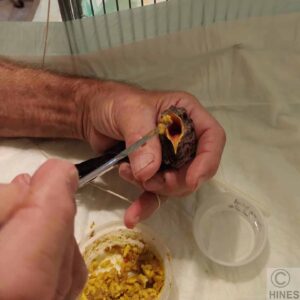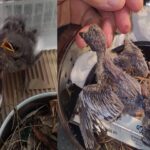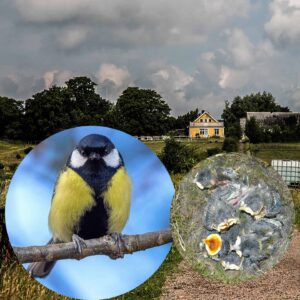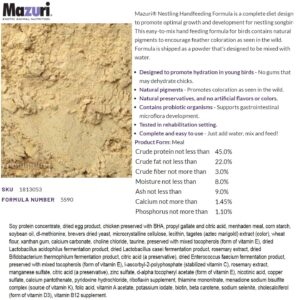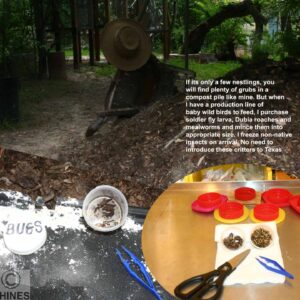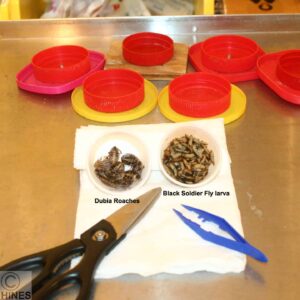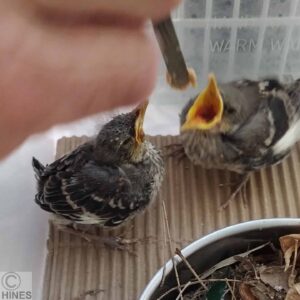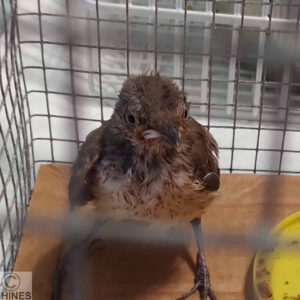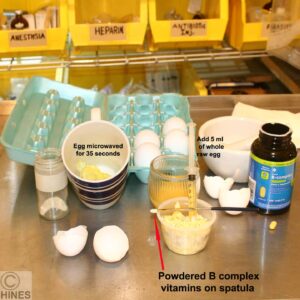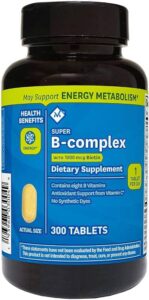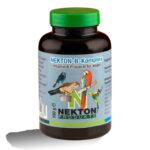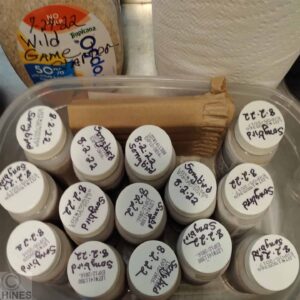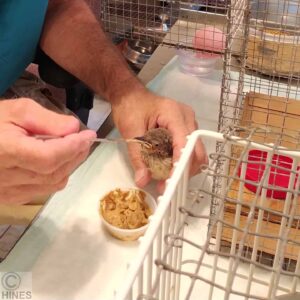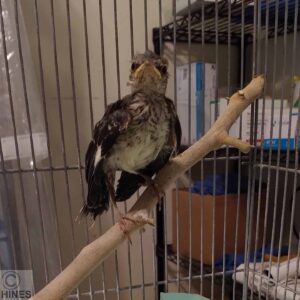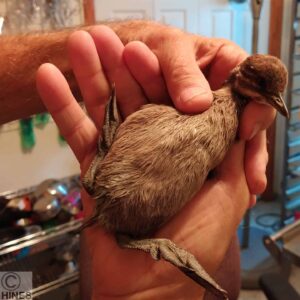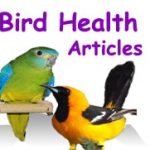 Portal To Other Bird Health Issues
Portal To Other Bird Health Issues
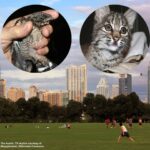 All Of Dr. Hines’ Other Wildlife Rehab Articles
All Of Dr. Hines’ Other Wildlife Rehab Articles
 Portal to all of Dr. Hines’ animal health care articles
Portal to all of Dr. Hines’ animal health care articles
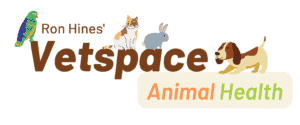 Portal to donation page for devices that don’t display it
Portal to donation page for devices that don’t display it
 Leg Weakness In Baby Songbirds And How To Avoid It? – Avian Neuropathy
Leg Weakness In Baby Songbirds And How To Avoid It? – Avian Neuropathy
Ron Hines DVM PhD
The takeaway point of this article is that supplemental B complex vitamins sometimes cure leg weakness in growing songbirds.
Songbirds (passerine birds) do not necessarily sing a pleasant song. They are a large group of the birds born featherless and dependent on their parent for food. These birds are called altricial birds as well. Songbirds are among the fastest-growing warm-blooded animals. They grow much faster than most mammals of the same adult body weight. For instance, a ~23 gram adult weight deer mouse weans its babies at ~30 days. However, a ~23 gram adult weight goldfinch sees its babies leave her nest (fledge) in less than half that time.
Why Is That?
It is because baby songbirds need to grow and leave their nests as quickly as possible to avoid being eaten. Youngsters confined to their nests, are easy prey for snakes, raccoons, squirrels etc. However, their greater threat are other birds looking for a quick easy meal – particularly blue jays, crows and grackles. Where I live, kiskadees fit that bill too. Most small songbirds achieve their full adult size within only 12-20 days after hatching. Songbirds that nest low to the ground such as wrens and field sparrows leave their nests at 12-13 days. So do those that nest on the ground such as larks. Low nests are easy to rob. But nesters that lay their eggs higher up for more safety such as blue birds average 17-18 days to fledging. Blue Jays fledge at 17 to 21 days. (read about that here) Another reason for their rush to leave the nest is that their parents do not store fat to fall back on for energy as mammals do. That is a tradeoff for their ability to fly. So finding enough food to feed their clutch is very stressful to feathered parents. In years when food is scarce, some songbird offspring leave their nest too early due to starvation. Any that fall behind in growth just a bit are often pushed out of the nest – probably in the struggle for morsels.
All of those factors make the early nutritional needs of songbirds, particularly for the ones fastest to leave their nests, a challenge for wildlife rehabilitators. One that many of the suggested songbird rehab diets might not always fulfill.
Most Wildlife Rehabilitators Have Been Faced With This Turn Of Events:
A nestling or two, less than 2 weeks old, arrives at your facility. Perhaps it was after a windy day. Perhaps the gardeners trimmed a hedge, a tree fell down, etc. The babies are tiny and barely feathered. You warm them up and they begin to gape. You feed them your choice of songbird recipes, and they do great for a week or two. But then you notice that their vent is pasty and moist, with clumps of stool adhering. You notice that they no longer back up to the side of their nest bowl to poop. One baby is often worse off than the other(s). So, you pluck the surrounding soiled feathers and gently clean the vent area with a pledget of cotton. You rearrange the nest bowl, add a new soft layer of shredded Kleenex, and check your temperature setting. The chick(s) continue to eat well but the problem persists. But then you notice that both the bird’s legs are weak. Their toes might be bending sideways. You know that these chicks are in trouble. But you don’t know why. Eventually, their appetite and weight gain drops off, and they appear depressed. At that point, their wings are no longer held tight against their sides. If they are old enough to have the urge to leave their nest bowl, they steady themselves with their wings extended as they attempt to move about their cage. Perhaps you feel guilty that you did not provide perching twigs early enough. Perhaps you feel guilty that perhaps you didn’t feed them frequently enough. Perhaps you think they didn’t get enough calcium or vitamin D3. Perhaps you think that something toxic or infectious is the cause. But you find no stress bars on their feathers, their bones are not deformed or soft, and they breathe normally with no nasal exudate present. These babies eventually die or have to be euthanized, while other baby birds you have of the same species do just fine.
Funds are always limited, but perhaps you then take their remains to a willing veterinarian and he/she diagnoses coccidiosis, gastrointestinal stasis/blockage or pneumonia; or tells you that their livers look abnormal. You’re frustrated and depressed about it. You wonder why you never see this problem in the baby owls, hawks, quail, ducks, doves and shorebirds you care for and release. But after a few days you move on – there are so many other foundlings that need your attention.
I have seen this scenario play out sporadically in the Chicago, San Antonio and Florida rehab centers I have volunteered at since childhood. But it does not necessarily take human intervention or error to produce this problem, at least not for the great tit of Europe – the bird you see above:
 Aug 9, 2022, 4:01 AM
Aug 9, 2022, 4:01 AM
Dr. Hines, I should say first that our tits are hole-nesters that breed in our nest-boxes, but otherwise free-living, so even in our experiments they feed on their own (i.e. I have not provided them with anything in addition to what their parents are feeding them – mostly caterpillars and some spiders in the case of the tits). Having said that I have seen these “soft” legs also in tit nestlings. It is quite uncommon though – I have worked with these birds for almost ten years but the number of nestlings that I have seen with this condition is no more than a handful. However, I know that my colleagues also have experienced this, so even though it does rarely happen, it does happen. My own, very anecdotal feeling about this is that it seems to happen at the end of the season – maybe suggesting that it could be due to the fact that some important food source is running out of stock. In general, nestling quality in the tits is almost always lower at the end of the season (most likely because they have missed out on the caterpillar peak). We have discussed this in our research group and discussed a possible lack of calcium that is interfering with osteosynthesis. In both blue tits and great tits it seems that a large number of spiders in the diet is associated with larger tarsus size (possibly via calcium or some other vitamin/mineral) but I don’t know if a lack of spiders in the diet is what is causing these soft legs. I think of the things you have tried, the only thing I can really think of is to add calcium to the diet and perhaps also vitamin D3 (to compensate for lack of UV-lighting, which is hard to make up for in indoor settings). All the best, F.A., Lund University, Sweden
Considering what Dr. Andreasson’s wrote, I have never seen this weak leg problem occur with evidence of deformed bones, as would be found in birds with a calcium or vitamin D-3 deficiency. It is not the splay-leg problem that I occasionally encounter when kindhearted but inexperienced folks keep nestlings on slick surfaces either. What caught my attention was Dr. Andreasson’s observation that end-of-the-season chicks born at times when food sources are not optimal or limited were more likely to suffer leg weakness. It is a common perception among American rehabbers I know that songbirds born too early or too late in their breeding season do not do as well as those born during peak season.
When I was in veterinary school, we were taught a bit about the diseases of poultry. One disease that was always mentioned was curly toe/perosis of fast-growing broiler chickens. It is a weak leg problem poultry farmers still deal with in rapidly growing strains of heavy meat chicken breeds; but almost never in slower growing chicken bred for their eggs. Perosis was traditionally associated with a manganese deficiency. However, when it is called “curly toe paralysis”, the most commonly cause is a vitamin B-2 (riboflavin) deficiency. Deficiencies in several other B vitamins are known to cause similar leg weakness issues in poultry. There is an excellent discussion of those symptoms in the current online Merck Veterinary Manual written by Dr. Steve Leeson of Ontario Agricultural College. I was able to access it today through this link. But the internet is unpredictable, if that link doesn’t open for you, ask me for Avian-Neuropathy- Leesman2022 .pdf, and I will send it to you.
Chickens are not songbirds. They have well-developed cecums and their genetics have been manipulated by humans for thousands of years. However, the signs described in the Merck Manual are quite similar to the weak leg problem wildlife rehabilitators occasionally see in their infant songbirds. These problems are all called neuropathies – pathology of the nerves. Affected chicks walk on their hocks. That progresses to eventual paralysis of both legs. Toes are generally clenched inward. Since the legs aren’t exercised, they shrivel. In poultry, riboflavin requirements are highest for newly hatched chicks during their early, maximum growth rate period. At that time (0-10 wks) some rapidly growing chicken breeds require 6-7 mg/kg (2.7- 3.2/lb) of riboflavin in their diet every day. In heavy breed chickens, reluctance to move often starts as early as 8 days of age. That is about the time when the riboflavin that the chicks obtained from their egg runs out. Most of the B vitamins including riboflavin were in its egg white. Most of its vitamins A, D, E and K were absorbed from its yolk. Riboflavin, and all B vitamins, being water-soluble, are rapidly lost from the chick’s body through its urine. Later in their early life, bacteria, particularly certain strains of Bifidobacterium and lactobacillus, colonize their lower intestine and produce riboflavin and the other B vitamins. When that occurs, their need for B vitamins in their diet decreases markedly. Many other intestinal bacteria have the ability to produce B vitamins as well. (ask me for Ferrario2017.pdf & Wilkinson2016.pdf) A lack of sufficient B vitamins eventually weakens muscles throughout the body – even the smooth muscle fibers of the intestine that are so necessary to prevent intestinal stasis or blockages.
The nutritional requirements of growing songbirds have never been determined. Doing so would be prohibitively expensive. No one knows which bacteria naturally occur in the digestive tracts of songbirds either. All we know is how necessary the vitamins these bacteria produce are. (read here) There are only two groups of land animals that are known to not require B vitamins in their diets as adults. The first are ruminants. The bacterial fermentation in their rumen provide them all the B vitamins that they require as adults. However, their calves, selected for rapid growth, often do need supplemental amounts of B vitamins added to their diet. The other large group of animals that obtain their B vitamins through fermentation, such as rabbits and tortoises, are called hindgut fermenters. They usually have large pouches or ceca attached to their lower intestine to facilitate that. But songbirds lack well-developed ceca, the usual place that fermentation takes place. (read here or ask me for Jortner1987) Poultry and many bird species other than songbird do have paired cecums (ceca) and much of their B-vitamin production occurs there. But during their early rapid growing period, after the amount they absorbed from their egg white runs out, they too are dependent on the B-vitamins present in their diets. The faster they grow, the more they need. Sometimes, they just can’t produce the amounts they need fast enough. When that occurs, treated poultry chicks with B-vitamin supplements often reverses leg weakness. In broiler chicks that is the case. It is also known that their leg weakness problems sometimes resolves on their own, as the riboflavin B vitamin-producing bacteria in their lower intestine increase in number. (ask me for Jortner198pdf, Cai2007pdf) Vitamin B2, riboflavin, is only one of several B vitamins that have been associated with leg weakness and neuropathy in birds.
Diet Choices
I worked for many years in zoos and federal animal colonies where cost was never a consideration. There I developed a lot of faith in the nutritionists and products of Mazuri/Purina mills. Until 1986, Mazuri was a division of Ralston Purina. But when Nestlé purchased Ralston, they did so to capture the more lucrative dog and cat food business. They wanted nothing to do with less profitable cattle and hog feeds. So, they sold that portion of Purina to Land O’Lakes which renamed it Mazuri. I believe that Mazuri has three veterinary nutritionists currently on their staff. Their songbird hand feeding formula provides a minimum of 45% protein, 22% fat (on a “dry”=3%-moisture basis) along with vitamins and minerals – all based on the needs of growing poultry – since no other data exists. The actual amounts are a trade secrets. The main ingredients are soy protein, dried eggs and chicken. It is generally fed mixed 1 part to 4 parts water or 1 part to 3 parts water – depending on if it is to be fed by syringe or spoon. They suggest that it be fed with “generous amounts” of insects, which makes its nutritional and vitamin composition hard to judge. However, an earlier recipe of that product was said to be equal to the commonly used FoNS© diet in effectiveness. (ask me for Mazuri Feeding Trial versus FoNS 2010) That one contained 9 mg/kg of B-1/Thiamine, 12 mg/kg of B-2/Riboflavin, 64 mg/kg of B-3/Niacin, 26 mg/kg of B-5/Pantothenic acid, 4.2 mg/kg of B-9/Pyridoxine, 1.6 mg/kg of Biotin, but only 0.048 mg/kg of B-12/Cobalamin. (ask me for Mazuri Hand Feeding Formula2016). No more recent analysis of the product is available on their website.
What Diet Do You Feed?
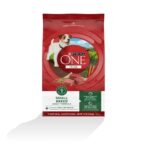
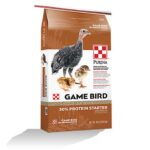
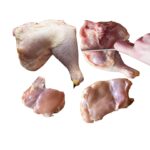
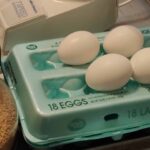
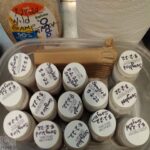
The diet I fed my baby songbirds this year was a combination of Purina ONE® + Small Breed Lamb & Rice Formula and Purina 30% protein Game Bird Starter. There were several other ingredients in this diet. (see all of them here)
Purina Support told me that the dog food contained 22.9 mg/kg of B-1/Thiamine, 15.4 mg/kg of B-2/Riboflavin, 142.9 mg/kg of B-3/Niacin, 42.2 mg/kg of B-5/ Pantothenic acid, 15.6 mg/kg of B-6/ Pyridoxine, 4.96 mg/kg of B-9/Folic acid-folate and 4.96 mg/kg of B-12/Cobalamine.
According to Dr. Biggs, a nutritionist at Purina Mills, The game bird starter contains 2 mg/kg of Thiamine/Vitamin B-1, 4 mg/kg of Riboflavin/B-2, 12 mg/kg of Pantothenic acid/B-5, 60 mg/kg of Niacin/B-3, 4.5 mg/kg of Pyridoxine/B-6, 1 mg/kg Folic acid/B-9: and 3 ppb. (0.003 mg/kg) of Vitamin B12/Cobalamin – Notice that that last entry ppb is parts per billion, not parts per million.
The 2022 AAFCO canine vitamin requirements for dog food for growing dogs are 1.0 mg/kg of B-1/Thiamine, 2.2 mg/kg of Riboflavin/B-2, 10 mg/kg of Pantothenic acid/B-5, 11.4 mg/kg of Niacin/B3, 1.0 mg/kg of Pyridoxine=Vitamin B6, 0.18 mg/kg of Vitamin B9/Folate and 0.022 mg/kg of B-12/Cobalamine:
Do Your Songbirds Receive Insects Too?
Yes.
When my compost pile can’t keep up with my need, I order mealworms black soldier fly larva and dubia roaches and serve them minced.
This year, 2022, fewer immature songbirds came to me than in normal years. South Texas and Northern Mexico are in a multi-year drought. Spring bloom, with its arrival of insects and berries arrived many weeks late. By midsummer, Deep South Texas was in the middle of the top five warmest and driest periods of the last 128 years. The hatchling that did arrive, arrived later than they usually do.
But among them this summer were two recently hatched mockingbird chicks and a slightly older curved-bill thrasher. They did well on my songbird diet for approximately 10 days. At that point, they began to show leg weakness and the other signs I mentioned earlier.
What Are My Options When Faced With Weak Legs In Songbirds?
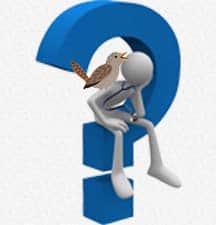 Brewers yeast is an excellent source of B vitamins and was found to correct leg weakness in rapidly growing chickens (read here) I have never attempted to add brewers yeast as a dietary ingredient for songbirds; perhaps you have. If so, let me know, and I will let others know. Brewer’s Yeast is a form of deactivated (killed) B vitamin-producing yeast, Saccharomyces cerevisiae. It is rich in all B vitamins – other than B-12/Cobalamin. The B-12 in supplements is derived from the industrial brewing of a particular bacteria. (read here) I know that several brands of avian vitamins are readily available to you. However, to the best of my knowledge, the companies marketing them do not tell you the source of their vitamins or their absorbability, directions are iffy, and they show no Third-Party verification seals. Neither the FDA nor the USDA verify what is in them, nor their effectiveness nor their claims nor their safety. Even if they had that desire, the FDA and USDA don’t, and never will have the bandwidth. The largest independent verification firm is Underwriters Laboratories. All human vitamins sold on Amazon or at Sam’s Club require periodic third-party verification certificates (COA & GMP) such as theirs. Amazon requires these two tests be performed every nine month. My wife and I purchase them at Sam’s Club.
Brewers yeast is an excellent source of B vitamins and was found to correct leg weakness in rapidly growing chickens (read here) I have never attempted to add brewers yeast as a dietary ingredient for songbirds; perhaps you have. If so, let me know, and I will let others know. Brewer’s Yeast is a form of deactivated (killed) B vitamin-producing yeast, Saccharomyces cerevisiae. It is rich in all B vitamins – other than B-12/Cobalamin. The B-12 in supplements is derived from the industrial brewing of a particular bacteria. (read here) I know that several brands of avian vitamins are readily available to you. However, to the best of my knowledge, the companies marketing them do not tell you the source of their vitamins or their absorbability, directions are iffy, and they show no Third-Party verification seals. Neither the FDA nor the USDA verify what is in them, nor their effectiveness nor their claims nor their safety. Even if they had that desire, the FDA and USDA don’t, and never will have the bandwidth. The largest independent verification firm is Underwriters Laboratories. All human vitamins sold on Amazon or at Sam’s Club require periodic third-party verification certificates (COA & GMP) such as theirs. Amazon requires these two tests be performed every nine month. My wife and I purchase them at Sam’s Club.
At the point that I recognized the three bird’s problem, I changed their diets to the mixture you see above. It consisted of one large whole, beaten egg, microwave-cooked for 35 seconds and the partial contents of one raw egg. These eggs, when cracked, provide about 48 ml of liquid content each. Then I chop up the cooked egg and add 5 ml of the uncooked whole egg, then mixed that well. There are two reasons I added the uncooked egg mixture. The first is because a small portion of the B vitamins are known to be destroyed by heating. The second is because the sticky raw egg liquid allows the vitamin powder I added to cling to the chopped egg pieces more uniformly.
To that mixture, I added 68.6 mg of powdered B-Complex vitamins. It was a brand I found at Sam’s Club: Member’s Mark Super B-Complex. Each vitamin tablet weighed ~ 0.63 grams (630 mg). I ground them into a power and added a small spatula portion of the powder to the cooked chopped and raw egg mixture. The powder on the spatula on a verified analytical balance weighed 0.0586 grams (58.6 mg). Double-checking the weight on a low-cost eBay pawnbroker-type gold scale was easily close enough in accuracy. The powder obtained from one vitamin was sufficient for 10-11 days.
Because of their high metabolic rate, chicks, and probably growing songbirds as well, require ten times or more the the amount of B vitamins per gram of body weight as human infants do. That is at least true for vitamin B-12/cobalamin. The fact that food eaten is only present in their short intestinal tract for 95–140 minutes might affect absorption as well. Another reason that I added what, I hoped, was a liberal amount of B vitamins is because chicken eggs contain avidin, which can inactivate another of the B vitamins, B-7/biotin. It takes over 4 minutes of boiling to destroy avidin. Not knowing how the egg avidin might affect songbirds, I hoped to override this theoretical problem with a small amount of uncooked egg. All bird eggs, including those of songbirds, contain avidin for reasons yet undetermined. Commercial hand feeding formulas that contain spray-processed powdered egg ingredients might also face this issue (read here) However, our local doves never have weak leg problems when fed from birth to flight on a diet that is ~ 50% instant oatmeal and 50% raw eggs. (read here)
If you don’t want to go through all that math and bother, you can purchase Nekton’s avian B-complex formula on Amazon.com, or have one of Walmart’s Drop-Ship Vendors mail it to you. That produce is manufactured in Dammfeld, Germany by Nekton, a highly reputable company. Their quality control chemist, Tatiana Stepanova, confirm to me that their product’s B vitamin content once every 2 months. In addition, the EFSA randomly requests 4 of their products for independent ingredient content and safety testing twice a year. I can’t tell you how much of their product they would suggest for songbirds. You could email them a link to this article and ask Tanya – I have bothered her enough already.
Western Europe is considerably more picky about their food safety than we are. For example, the USDA allows 0.02 mg/kg (~0.009 mg/lb) of aflatoxins in you and your pet’s food. The EFSA allows only half that amount, 0.01 mg/kg (~0.0045 mg/lb).
Once the birds regained the full use of their legs, I added approximately the same amount of powdered B vitamins to 22 grams of their prepared food. That food consisted of approximately 40% pre-soaked Purina One +PLUS small breed Lamb & Rice Formula Dog Food, 30% Purina wild game bird starter, 10% raw, skinned, deboned chicken quarters with the fat and bones removed, 10% whole hard-boiled eggs and 10% canned Purina Friskies Shreds Chicken in Gravy canned cat food. The Friskies Shreds is a product I have used to stretch natural ingredients for many years. It gives a smoother texture to the final product due to the emulsifiers it contains.
After the three birds recovered and matured, I left their flight cage doors open after their morning feeding. By then they ate on their own. All were gone by evening. It’s November now, and a mockingbird (with a slightly shorter-than-mature tail) has taken up residence in the anacua tree outside my computer room window. Mockers fiercely protect their favorite berry trees from interlopers. This one is a bit too relaxed to my presence. Perhaps it is one of the two I released last summer. I’ll never know.
I did get another call late this summer about a “baby bird” with leg deformities so severe that it could not walk. It turned out to be the little grebe you see above. Nature designed them for swimming, not walking. The best they can do is push themselves along.

Dear reader, Besides your donations, visitors to the products that Google and others display on my website help me defray the cost of keeping my articles on the Web – and you informed. As you know, sites like mine that intentionally use no AI, no SEO, and are not written to Sell You Things are getting harder and harder to find, Best wishes, Ron Hines

